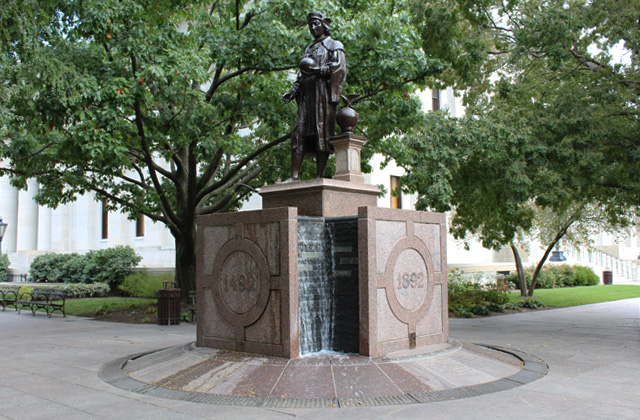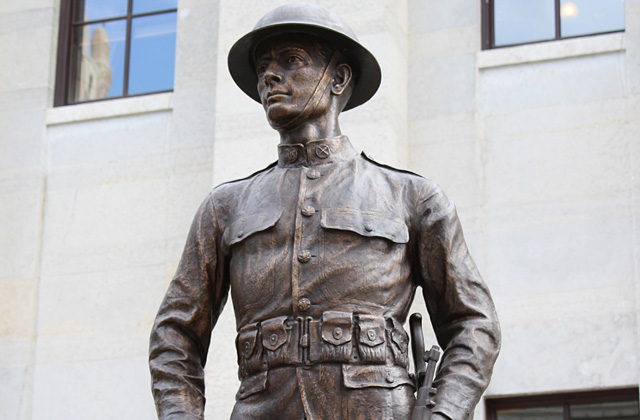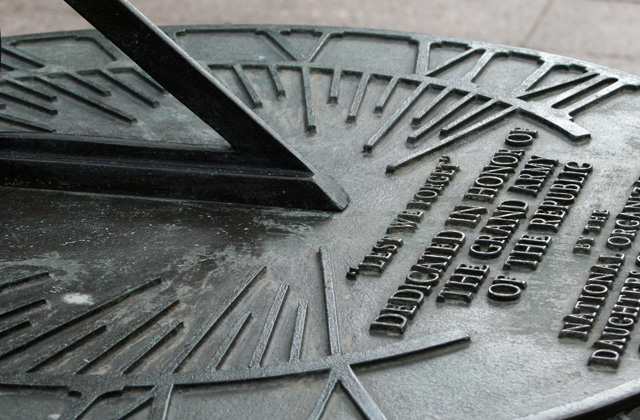About
Visit
Museum
Photos
Video
News
Events
Roof and Building Improvement Project - click on Announcements
thru Dec. 19 - noon choirs sing on weekdays



"William McKinley Monument"
 The west side of the Statehouse and Capitol Square is dominated by the William McKinley Monument, a monumental grouping of statues that honors the nation's 25th President, an Ohio native who was assassinated in 1901.
The west side of the Statehouse and Capitol Square is dominated by the William McKinley Monument, a monumental grouping of statues that honors the nation's 25th President, an Ohio native who was assassinated in 1901. McKinley was born in 1843, the seventh of nine children of a Scots-Irish family of humble circumstances living in Niles, Ohio. The family moved to nearby Poland, Ohio to take advantage of better schools in that area. Upon completion of high school, McKinley attended college for one term before enlisting in the Union Army in 1861. There he served as a Private in the 23rd Regiment of the Ohio Volunteer Infantry, a unit commanded by another future President, Rutherford B. Hayes. When he mustered out in 1865 at wars end, McKinley's combination of initiative, integrity and bravery had earned him several promotions, and he left the service a brevet Major, and would usually be referred to as "Major McKinley" until his election as President.
McKinley completed his legal education after the war and was admitted to the Ohio Bar in 1867. The passage of two years would bring about several life altering events for the young lawyer, when in 1869 he entered politics with his election to the post of Prosecutor for Stark County, and in that same year began courting the vivacious and pretty young woman who would become his wife, Ida Saxton.
McKinley's initiative and integrity and his warm humble personality would see him succeed as county prosecutor and lead to a long stretch in the US Congress representing the Stark County area. He was elected as Ohio Governor in 1891 and easily won reelection to a second term. As the Republican nominee for President in 1896, McKinley waged a "front porch campaign" that emphasized the essentially modest and humble character of the man, and he won the election by a wide margin. He repeated that landslide victory when he was elected to a second term in 1900, but tragedy would ensue and he would not complete his second term.
While touring the Pan-American Exposition in Buffalo, New York, McKinley was shot twice at close range. Initially his doctors thought he would recover, but eight days after the shooting, McKinley died, launching an enormous wave of public mourning and grief that would envelop the nation and much of the world.
Almost immediately, Columbus residents began to consider some permanent memorial to the native son of Ohio who the nation looked on as a martyr. A committee of local notables began the effort, and city newspapers solicited public donations. The total cost of the monument was $50,000, half of which was provided by the legislature and the remainder from individual contributions of pennies, nickels, dimes and quarters. Hermon A. MacNeil of New York executed the sculptural figure of the President at the monument's center, basing his depiction upon photographs, information provided by friends and associates of the late President as well as a model who posed in clothing provided by McKinley's tailor.
On either side of the monument are flanking statues representing "Peace and Prosperity". Each is depicted as an adult figure guiding and instructing a youth, representing the next generation. The adult female figure of Peace, a palm of peace grasped in her hand, draws a little girl close to herself to confide that the greatness of the nation is in her peaceful pursuits, while the adult male figure of Prosperity instructs a young boy in the use of the tools of industry, the basis of so much of the nation's prosperity.
A crowd of over 50,000 people attended the September 14, 1906 unveiling of the monument, the largest crowd to attend a Statehouse event up to that time. They were drawn in large measure by the memory of the recently departed President, and also by the guest of honor at the unveiling, Alice Roosevelt Longworth, wife of an Ohio Congressman and the daughter of McKinley’s Vice President, Theodore Roosevelt. Dubbed "Princess Alice" in the media of the day, Mrs. Longworth was known for her up to the minute fashions, daring behavior and tart tongue.
When an underground parking garage was constructed beneath the West lawn in the 1960s, the McKinley Monument was temporarily displaced. When it was rededicated in a new location near its old home, Governor James Rhodes struck a common theme speaking of McKinley, Rhodes spoke of the basic humility and honor of the man he called "the nation's last cavalier. The old fashioned values which helped make America great were deeply rooted in William McKinley."
Even the location of the statue pays tribute to the devotion this humble man had for his wife. The statue gazes west across High Street to the site of the old Neil House Hotel, where the couple resided during their time in Columbus. An energetic woman in her youth, Ida McKinley's health declined greatly during her time as First Lady of Ohio. She was frail and often bed ridden. Her devoted husband was always hesitant to leave her, even when official duty called. Every morning, as he walked to work across the street McKinley would make a point of waving to his wife as she gazed out the second story window.
 Holiday Festival and Tree Lighting 2025
Holiday Festival and Tree Lighting 2025 Holiday Santa Photos 2025
Holiday Santa Photos 2025 Flags for 9-11 in 2025
Flags for 9-11 in 2025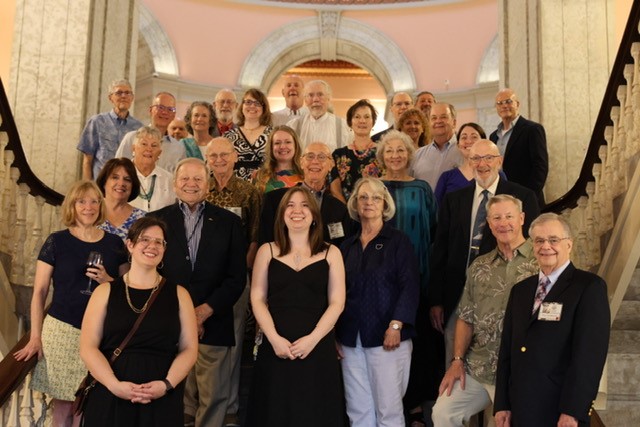 2025 Volunteer Appreciation Dinner
2025 Volunteer Appreciation Dinner America 250-Ohio
America 250-Ohio Holiday Festival and Tree Lighting 2024
Holiday Festival and Tree Lighting 2024 Ohio Constitution Videos
Ohio Constitution Videos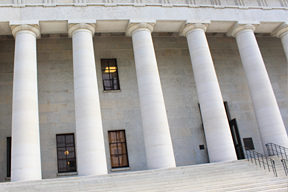 Ohio Statehouse Videos
Ohio Statehouse Videos












